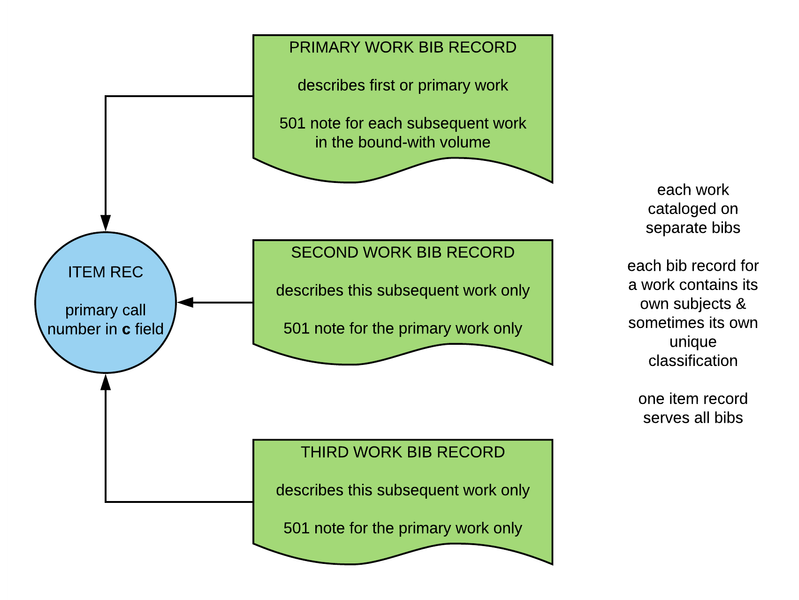Bound-withs
MSU TechServices
Summary: Instructions for cataloging two or more monographic works bound together as one physical item.
General info
A bound-with contains multiple works that need to be cataloged on separate bibliographic records, but each bibliographic record is linked to the same item record to facilitate circulation of the single physical piece.

For more information about and diagrams of different types of multipart works, visit Multipart works explained.
Catalog primary work
The primary work is usually the first work in the bound volume, but exceptions may occur. The cataloger may use their judgment in these situations.
Assign subjects
- Assign LC classification number
- this will serve as the effective call number in the item record for all works in the bound volume,
- however, subsequent works may be given different classifications (see below for more details)
- exception: if the bound volume has already been given a classification that does not apply to the primary piece, maintain this as the effective call number
- this will serve as the effective call number in the item record for all works in the bound volume,
For each subsequent work in the bound volume, add a 501 note:
- Bound with: Author [use AAP form] ; Title. Edition. Place of publication : publisher, date. |5 MiEM
- only the bib record for the primary work will contain a complete list of all the titles that are bound together (bib records for subsequent work(s) will only contain a note for the primary work)
- Formulate 949 string to create both holdings and item upon import
- adjust workstat to reflect the total number of works you are cataloging in the bound-with volume
- example: cmsorigmonoahf,4
- adjust workstat to reflect the total number of works you are cataloging in the bound-with volume
Catalog and link subsequent work(s)
Each subsequent work is cataloged on its own separate bib record.
Assign subjects
- Assign LC classification number if desirable/necessary
- will likely be needed for full-level cataloging in OCLC
- a class-only 050 is acceptable for a full-level record
- otherwise, records would need to be coded as K in the ELvl field
- also useful for works with sufficiently different subject matter
- in general, promotes data cleanliness and represents an investment in the success of any future conversion work
- however, if too many works are included in the bound-with for unique call numbers to be feasible, use the primary call number and make necessary adjustments
- will likely be needed for full-level cataloging in OCLC
- Add 501 note for primary work:
- Bound with: Author [use AAP form] ; Title. Edition. Place of publication : publisher, date. |5 MiEM
- Formulate 949 string to only create a holdings record upon import
- enter call number in holdings record call number field only
Create links in FOLIO Inventory
Notes
- Relationships are created between the single item record and multiple holdings records.
- This is easiest to do with two separate browser windows open side by side.
Steps
- Window 1
- Open primary work's instance record in Inventory
- Click barcode to open item record
- Actions → Edit
- Scroll to the bottom section for "Bound-with and analytics"
- Click "Add Bound-with..." button
- Window 2
- Open instance(s) for subsequent works
- On each instance, click "View holdings"
- Copy holdings record(s) HRIDs
- Paste into open dialogue in Window 1
- Window 1
- Click "Save and close" after all linked holdings
After saving, on the primary work's item record view, you should see the title of the primary work as well as the other works it's connected to.
DCRM(B) on bound-with materials
These excerpts from DCRM(B) pertain to cataloging bound-withs and may be helpful to catalogers.
7B18 “With” notes
If the description corresponds to part of a publication that is made up of two or more separately titled parts that are also separately paginated or foliated and have separate signatures, but which have been issued together, make a note beginning “With” followed by a colon. List the other parts of the publication in the note, in the order in which they are found. In the case of bound volumes, list all the other parts on the record for the first part and, in general, only the first on the records for the subsequent parts. (Do not make such “With” notes when the pagination, foliation, or signatures of separately titled parts are continuous with the part being described. Instead, record these titles in a contents note as instructed in 7B16.)
7B18.2.
For each work listed, give only the elements listed below:
- a) the heading; normally give this element first, usually in catalog-entry form (e.g., with inversion of personal names under surname, but not necessarily including personal birth/death dates, corporate qualifiers, etc.)
- b) the title proper as found in the record for the work; long titles may be shortened (whenever the uniform title is considered useful for the identification of the work, record it within square brackets preceding the title proper)
- c) the primary statement of responsibility as found in the title and statement of responsibility area of the record for the work, unless it is redundant of the heading or exceedingly lengthy
- d) the publication, distribution, etc., area as found in the record for the work, abridged as necessary, without using the mark of omission
With: Dunton, John. The merciful assizes, or, A panegyric on the late Lord Jeffreys hanging so many in the West. London : Printed for Eliz. Harris, 1701
7B18.3.
If the works were bound together subsequent to publication, rather than issued together by the publisher, distributor, etc., make a local note according to the instructions in 7B19.3.4, if considered important.
| Contact | Joshua Barton or Autumn Faulkner |
| Team | CMS |
| Updated | May 2024 |
| Created | July 2018 |